Just like many other European powerhouses, Bayern Munich are a team that looks toward the future. The Bavarians have always been stacked with talent, both young and old, and their current iteration under the genius of Julian Nagelsmann is no different. However, some talents are just different from others. Mathys Tel, for example, the newest prodigy secured from the famous Stade Rennais academy for a reported €28M, is a projected elite of the highest order.
Having sold Robert Lewandowski to FC Barcelona, it’s understandable Bayern would be looking to replace him. However, Tel, as good as he is, is not exactly a Lewandowski replacement. Or at least not just yet. The 17-year-old follows the footsteps of other former Ligue 1 starlets like Eduardo Camavinga or Aurélien Tchouaméni, both of whom are now Real Madrid players, and will be looking to etch his name in the stone of future elites.
Despite his tender age, there is already reason to believe Tel will indeed stand among the greats sooner rather than later. The France U17 captain became the youngest player ever to feature for Stade Rennais when he came on for the final five minutes in their 1-1 draw against Brest in August 2021, aged just 16 years, three months and 19 days. Similarly or even more impressive is the fact Tel also became Bayern’s youngest-ever goalscorer when he netted a strike against Viktoria Cologne. On that fateful 31 August, the French prodigy was only 17 years and 126 days old.
Granted, his senior football resume is not as impressive yet but for a 17-year-old, this isn’t all that surprising. Still, five goals in six games for France’s U18 squad and five in nine for the U17 side are good indicators of his quality. Similarly, Tel has netted six goals in six appearances for Stade Rennais’ B team, immediately demonstrating his level. But who is this young prodigy and what are the details behind his success?
This tactical analysis will provide you with a scout report on Mathys Tel, giving you a full analysis of his profile as well as explaining how it applies to both Bayern’s and other elite teams’ tactics.
Player overview
Mathys Tel is a 17-year-old forward currently playing for Bayern Munich in the Bundesliga. Standing at 183cm (just over six feet), the youngster is athletic, strong and tall. It has to be noted that his body mass ratio is good and despite having long legs, he isn’t lanky or too skinny for his frame. One of Tel’s best attributes, however, is the sheer versatility of his profile.
Even though he’s right-footed, the Frenchman is quite adept with both feet, making combination play and ball-striking in general much more fluid and easy. But it’s not just his ambipedal nature that’s fascinating to dissect. Tel can be deployed anywhere across the frontline and has even played in midfield and defence earlier in his youth career, albeit briefly.
He is also quite fast and loves to dribble. This, alongside his lethal nature, technical quality and physical presence, makes for an incredible combination of crucial traits when trying to predict a player’s ceiling. Tel’s capacity for the spectacular is immense and he is, by all means, a projected Ballon d’Or winner somewhere further down the line. This may seem like an exaggerated statement but given his profile and mentality, the assumption is still based on sturdy foundations.
Dribbling & PnP
One of the very interesting and exciting aspects of Tel’s profile lies in its combination of physique and technique. It’s not often that we encounter physical specimens who are good in tight spaces, offering a wide range of different but equally important traits for all phases of play. Tel is a great dribbler, an outlet in transitions and a very explosive presence on the flanks. This, in turn, is why he’s been deployed as a winger quite often throughout his young career.
We’ve already mentioned how he’s almost equally adept with both feet and this makes him a good fit for both the left and right-winger roles. However, it does seem he prefers the right foot ever so slightly and the role of an inverted left-winger or an inside forward on the left suits him to a tee. In the next visualisation, you can see Tel’s career ‘winger actions’, depicting dribbles, crosses and general movement.
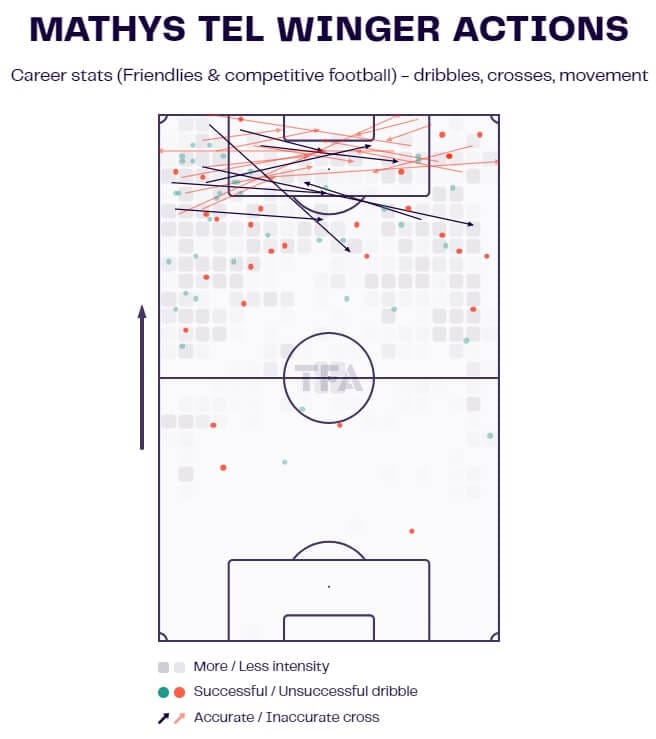
Immediately, we notice the 17-year-old is largely active in his respective half-spaces, depending on the side he’s deployed on. Even when he starts wide, Tel will almost inevitably cut inside and aim to get closer to the central areas of the pitch as this provides him with a better platform to both shoot and create from. Interestingly, the half-spaces are also the areas with the most dribbling activity too. Given their importance in creation and progression, this doesn’t come as a big surprise.
Generally speaking, Tel won’t advance high and wide when progressing up the flanks as this forces him into a more predictable set of actions – crossing. Having been deployed largely on the left side and considering his left foot is still comparatively weaker, it’s easy to see why he wouldn’t prefer the wide, natural winger role. He can still be dangerous when he beats his man and crashes into the box but the closer he is to the goal, the better. We’ll discuss his lethality further down the line of this analysis.
Staying on the topic of dribbling, however, let’s discuss how Tel’s ambipedal nature and technique help make him an almost unstoppable force when he gets going. We’ve already mentioned the youngster has long legs and while that may seem like a trivial thing, it does affect his pace and power. Players with longer strides can be very difficult to stop and Tel is certainly one such player. It’s equally important to note, however, that he controls the ball with both feet, taking inside and outside touches both to protect the ball and keep the defender guessing.
Take the following sequence of play as a great example of the unpredictability factor in his technique.
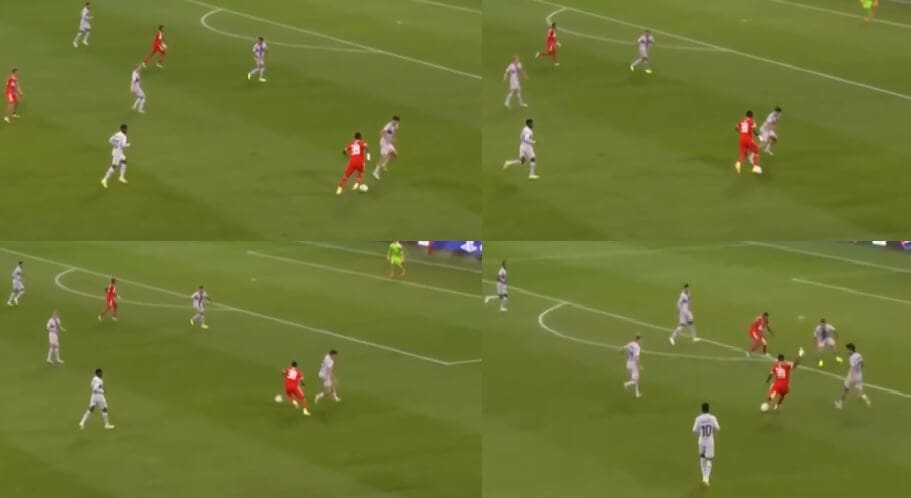
Here, Tel is cutting into the half-space and is engaging the defender in a 1v1 duel. But take note of how he faces his opponent, touching the ball with the outside of the boot in the first image, the instep in the second and then finally with the instep again in the third before setting himself up for a shot outside the box. This keeps the defender guessing as to where Tel might actually go and given his ambipedal nature, either side is equally possible as it gives him a multitude of angles to exploit.
Considering the Frenchman is also incredibly pacey and strong, marking him becomes an incredibly difficult job to do. One other important facet of his dribbling – but also finishing too – is the way he uses his frame to protect the ball. Many players make the mistake of being too exposed when dribbling. But not Tel. He uses his body well to shield the ball, mostly relying on his weak foot to stop the marker while the right is used to control. And this is an important aspect to consider as well.
Tel is adept at playing with both feet but his preference for his right foot is clear. This can be seen in the way he passes, shoots and controls the ball. When receiving possession, he will mostly do so with the inside of his right foot and that can be manipulated to increase the chance of miscontrol. But more on that in the next section of our scout report. Back to dribbling, however, it’s important to note the way Tel dribbles from a standstill as it differs highly from his in-motion dribbling.
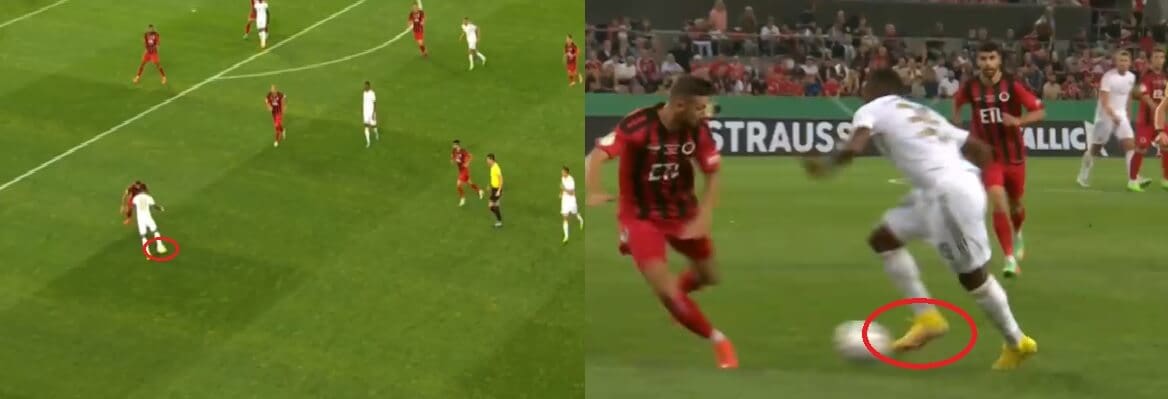
We’ve seen earlier how he uses both feet to control when he’s in motion but going from a standstill to beat a marker, Tel will generally use his right instep and drag the ball across his body. This can be seen in the latest example depicting such a sequence in two images. The 17-year-old generally takes small inward touches when controlling before dragging or kicking the ball in the direction he wants to go, as depicted in the image.
Considering he can burst into high speeds from a standstill, this technique is still effective, albeit highly reliant on the aforementioned sudden change of pace. Additionally, it also limits the angles he can operate in and makes his trajectory far more predictable than usual. That, alongside his known preference for his right foot when controlling and starting dribbles, can be used when defending against him or at the very least lessening his impact. But as mentioned, when he’s in full flight, Tel can be nigh-impossible to stop.
This is generally because he combines power, speed and technique in such an efficient way the defenders are, more often than not, no match for him. Such a combination of skills makes him an absolute menace in transitions.
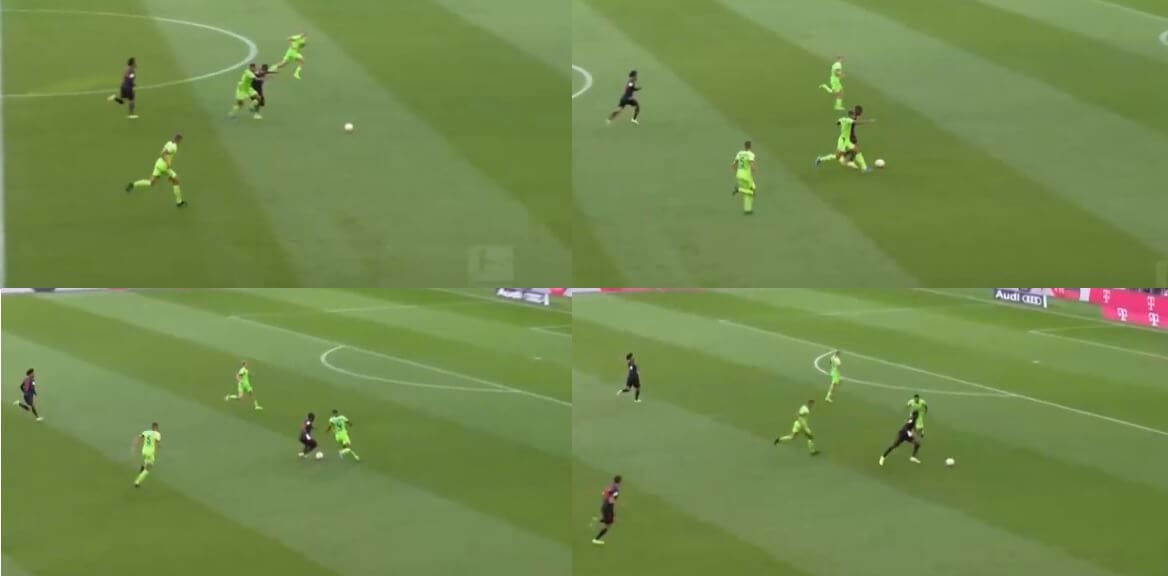
Take this sequence as an example. Tel gains possession in the opposition’s half of the pitch, immediately engaging in a duel with the defender. Before long, he’s not only outmuscling and outrunning his rival but also dribbling past him to assume a higher position closer to the penalty area. It’s there he can then link up with the overlapping teammate to the right. Again, when in full flight, Tel is an unstoppable force of power and speed.
This particular action shows us how he uses his frame to protect the ball, how he changes speed incredibly quickly but also how agile he is in spite of his physique. If you find yourself in a direct duel against Tel when he’s already chasing the ball, chances are you’re going to lose. The trick is to stop access to him in the first place. But that’s also easier said than done.
Our final example showing his PnP attributes can be seen next. This time, similarly to the previous sequence, we see Tel duelling for the ball, only this time, it’s against two defenders and from a far less favourable position. And yet, he still wins it.

While this is an excellent example of his pace and power, it also shows an elite winning mentality. Not many players would dare to try, let alone dream of winning this duel, but Tel does both.
Passing & technique
Even though Tel is a forward first and foremost, his overall technical levels are astoundingly high. This becomes even more impressive when factoring in his frame. A six-foot-tall player shouldn’t be as agile and as technical as he is but this is exactly what makes him such a special talent in the first place. We’ve already mentioned Tel has played as a midfielder in the past and a big part of his technical know-how may stem from that period.
If we explore his career heatmap, we can see he’s been deployed everywhere across the opposition’s half of the pitch. Having been predominantly used as a winger, however, the activity is notably higher on the flanks, as is the intensity of his actions.
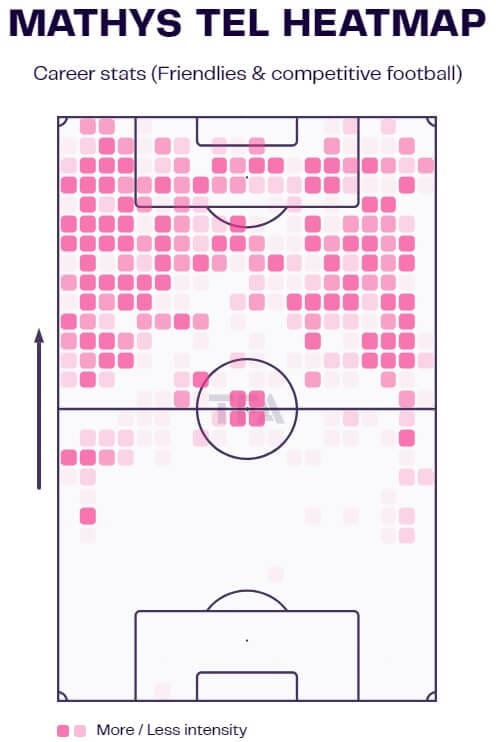
Once again, we can see the preference to cut inside, which takes him into the respective half-spaces. This brings us to his passing traits and overall technical quality. Tel isn’t an elite creator. He never was. So we cannot claim this is a prominent part of his repertoire. However, when it comes to link-up and combination play in the higher areas of the pitch, he is more than capable of delivering quality sequences.
Usually, these will involve short lay-offs or one-twos with his teammates to access the critical areas of the pitch. As with everything else in his arsenal, the closer he is to the goal, the more effective he becomes. This rule generally applies to his passing too. Tel can deploy quick one-touch passes into the channels, which have become a trademark when it comes to his link-up play.
The following example demonstrates this almost perfectly. We find Bayern pinning their opposition back as they advance deeper into the final third and Tel is playing in the left-winger role, occupying the left flank and waiting for the ball to get to him.
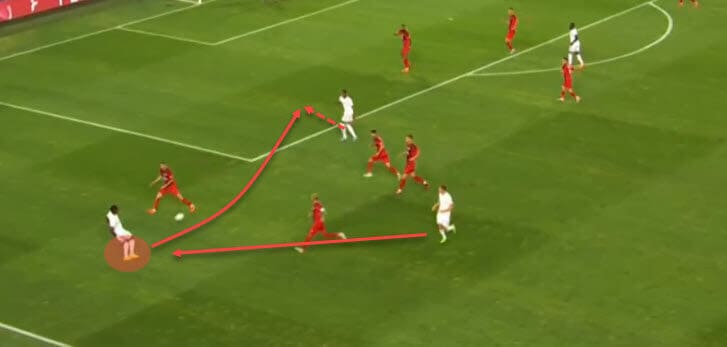
The most impressive thing about this particular sequence is the ease with which the pass is successfully deployed. While it may seem like a simple ball, it’s far from it. Especially considering Tel plays it first-time. The curve, power and the trajectory are all on point and Bayern advance play following a single flick-on from the young Frenchman. Of course, the opposition had already left the area unoccupied but it was still difficult to access.
One thing to note when it comes to Tel’s passing, however, is once again the preference for his right foot. He may be perfectly capable with his left but in situations like these, he will mostly rely on his dominant foot. This isn’t a big flaw as most players tend to function that way but is a point of concern if the opposition manages to manipulate it properly. Again, Tel will use the inside of his right foot for the majority of these passes as that brings him the most control.
One thing we have noticed while analysing his profile is the heavy first touch in some of the instances when he’s trying to control a pass. Generally speaking, this isn’t a big issue but occasional miscontrol can and does occur.
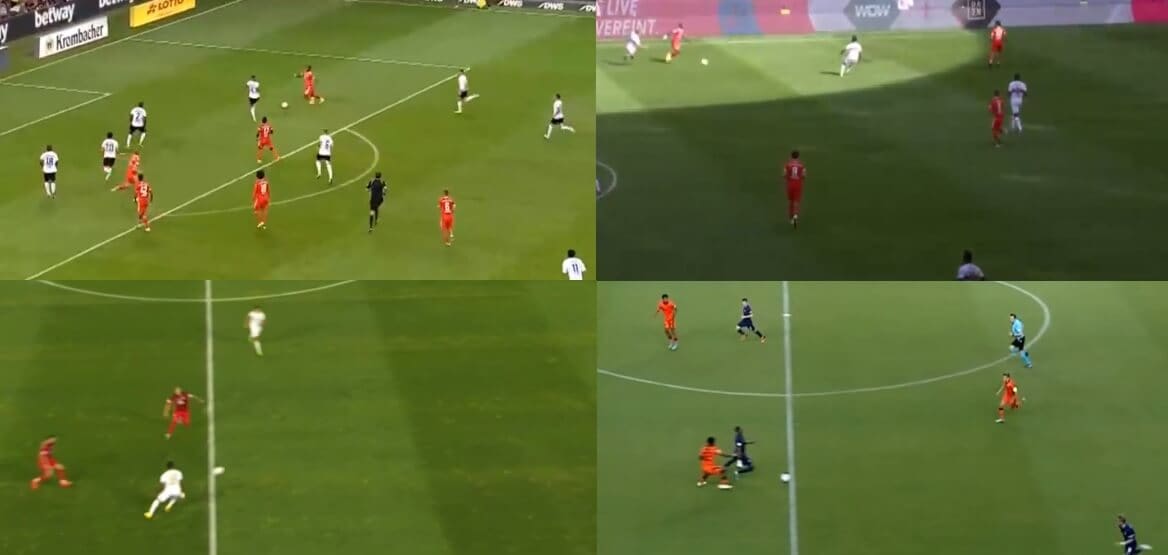
In this example, we can see such occasions. The reason we’re pointing them out is that most happen when he doesn’t have the time or space to control the ball with the inside of his right foot and is forced either to his weak foot or to control it with the outside of the boot. In such situations, the chances of micontrol increase. Again, Tel’s technical level is impressive when put into the proper context but as good as he is – or can be – in certain situations, he isn’t a tight-space monster. At least not yet.
But while his technical quality may still need refinement, it’s impressive how high his footballing IQ is. Heavy touches are generally press triggers telling defenders to collapse or attempt an interception but this can be used to manipulate and exploit such actions. Even though he doesn’t do this at a high rate, Tel knows how to do it effectively. Especially in situations where he can then beat his marker and progress play.
The following sequence is a great example demonstrating this trait used to its full potential.
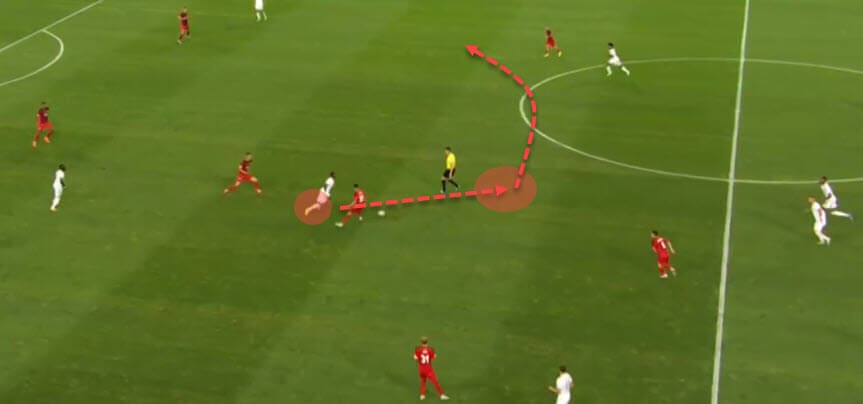
In this situation, taking a heavy touch is favourable as it takes the ball away from the congested area and into open space following an attempted collapse from the opposition. Identifying and then exploiting that space using a single heavy touch to escape pressure is a great proof of a high footballing IQ. For a 17-year-old player, this is already stepping into advanced mechanisms territory.
Finally, we have to touch upon Tel’s capacity for the spectacular once again. When it comes to chance creation via passing, he likely won’t rank amongst the elite. However, he is such a big talent across the board that there is always a big moment in him; maybe it’ll come out in the dying minutes of the game or it’ll be a flash of brilliance when you least expect it but more often than not, it will arrive.
When we combine his excellent physical predispositions with a high footballing IQ and impressive technical levels, we get incredible sequences like the one seen in the following example.
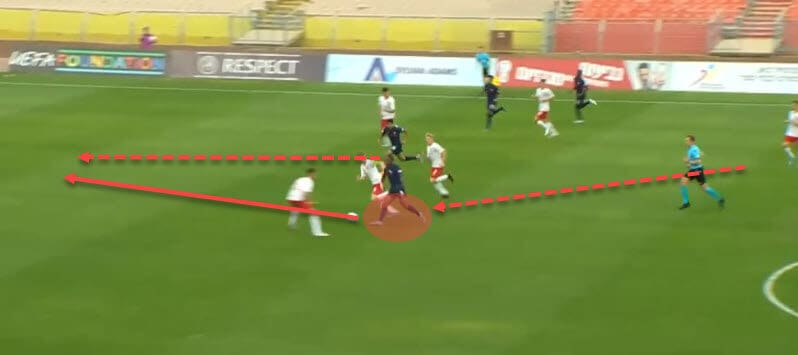
In this action, Tel is in full motion, carrying the ball upfield from a deeper position. Not only does he recognise the space but he accesses it following a slight feint to deceive the markers and uses the outside of his boot to deploy the pass. Of course, a slight caveat is that this isn’t his ordinary passing performance. We cannot and shouldn’t expect him to replicate elite levels of creativity in every single game.
But as mentioned earlier, his capacity for the spectacular means sequences like this one are always somewhere around the corner.
Shooting & movement
The final and arguably the most important aspect of Tel’s profile we need to discuss is his lethality. In this section of the analysis, we’ll delve deeper into the shooting techniques and the accompanying movement to find out what makes him so special. “I have the vision that he could score 40 goals [in a season like Robert Lewandowski] one day in the future,” said Nagelsmann about his new talisman, as reported by Bundesliga’s official website. Quite clearly, we’re talking about a phenomenal talent.
So let’s explore his goal-scoring traits a bit further. The next graph depicts Tel’s career shots and the expected goals (xG) values they accumulated. Note, again, that we’ve resorted to using career stats as opposed to this season’s data as the sample simply wouldn’t be sufficient in the latter’s case. Still, when talking about such a young player at the very beginning of his senior career, this will be a good resource to analyse.
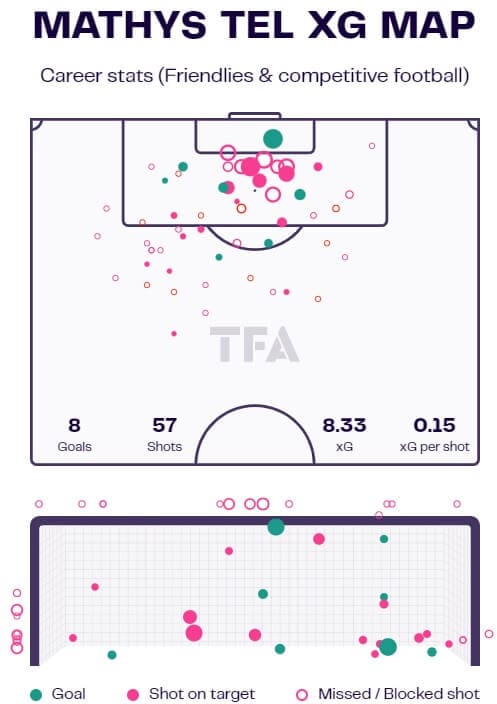
We can see from the graph that Tel has scored eight goals from 57 shots, accumulating a total of 8.33 xG in the process as well. This tells us he’s slightly underperforming the expected goals value but the 0.33 difference is slim enough to make this a minor issue. What does present a bigger flaw, however, is the composure and shot locations of these attempts. Tel has a powerful shot in his locker but the main reason his xG per shot stands at ‘only’ 0.15 are the outside-of-the-box attempts.
If we count only the last 30 shots in competitive football, 12 of those were taken from a distance and four hit their target. One of them yielded a goal, too. Out of the last 57, 25 were taken outside of the box with eight hitting the target and two rattling the inside of the net. Whether that’s still a good enough return to justify so many low-xG attempts is still up for discussion. To address the ‘low’ xG per shot return of 0.15 – this figure on its own would already be quite good, especially if we say everything around 0.2 and above is world-class. However, poor shot locations or rather, a tendency to shoot from distance made Tel’s return seem much lesser than it actually is.
Another thing to note is the success of close-range shots. The good news is most of Tel’s goals have come from central positions in the box, optimising his chance of scoring. The bad news is that this graph could indicate a lack of composure. This is best demonstrated in the finishing issues he encounters as there seem to be more high xG misses than goals in the zones close to the penalty spot. Again, just finding yourself in those areas to shoot is an excellent foundation for a good goal-scoring career but the lack of composure is, for now, undermining the overall success rate. On a large enough sample, the goals should, in theory, be almost inevitable should this close-range shot location trend continue.
All of this gains even more weight when we include his elite movement and shooting techniques, both of which we’ll discuss next in this scout report. Let’s start with the former. As we’ve seen from the previous section of the analysis, Tel’s role gives him the freedom to roam the flanks and connect with teammates in the central channels. This dynamic movement makes use of his exceptional understanding of the game as well as his physical predisposition to dominate his rivals.
Take the following sequence as an example.
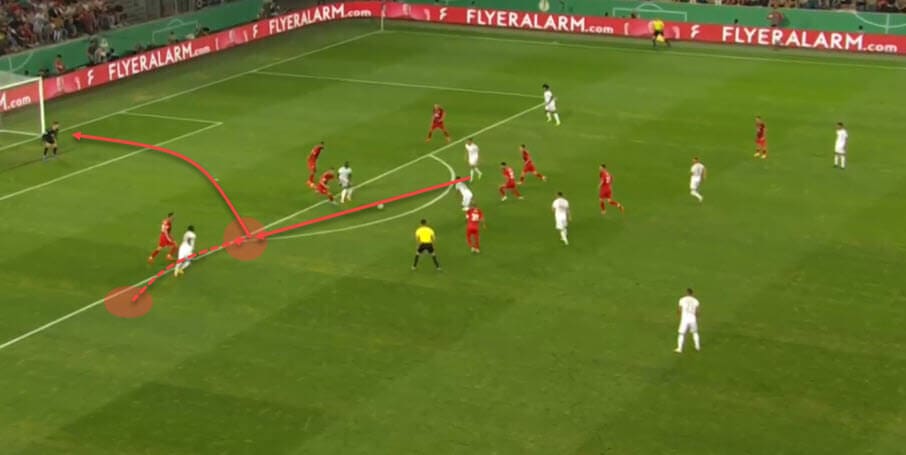
While this may seem like a fairly simple action to execute, the timing, reading of the play, physical advantage and finally the shooting technique are all impressive. Note, however, that the attempt doesn’t end in a goal but serves to show us the movement before the shot takes place. Tel goes from a standstill to a burst of speed in an instant, leaving the defender unable to track his run and ultimately, letting the shot go through with little to no obstruction.
The speed and power on display here go well with his ball-striking technique but more on that a bit later in this tactical analysis. Speaking of his PnP attributes again, however, they must be mentioned in the context of his goal-scoring prowess. Being more powerful and more rapid than your markers is an excellent tool to have, especially when you’re poaching for chances inside the box.
Our next couple of examples cover both of those aspects in direct goal-scoring situations. The first one is a demonstration of pure speed.
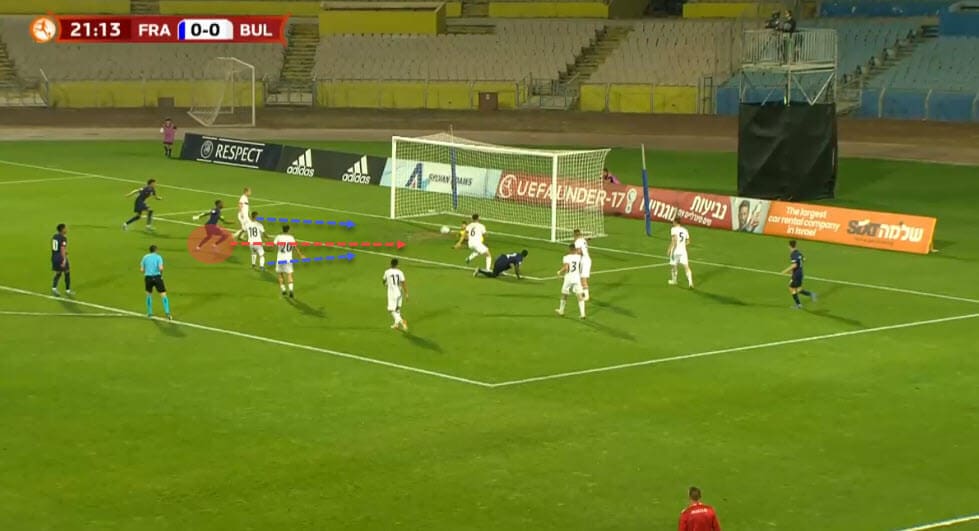
Just like in the sequence depicting his movement prior to taking a shot, this one shows us Tel’s incredible burst of speed from a standstill position. Note, once more, the 17-year-old is starting behind his markers when the pass ricochets off of the goalkeeper but still manages to get to the ball before the defenders. Here we can also draw parallels to the PnP transition example from the first section of the analysis where Tel had to blaze past two defenders to get to the ball first.
But the big difference is, neither of these two defenders is even expecting the ball to bounce their way, let alone attempt to beat the young forward in a foot race. Tel, however, can smell these chances from miles away. Even before the ball starts its trajectory towards him, he’s already in motion, lunging to meet it. It’s a sign of very good poacher instincts.
Similarly, his strength is equally useful in that scenario, as can be seen in the following example. Now, instead of outrunning, Tel outmuscles his marker to reach the ball first.
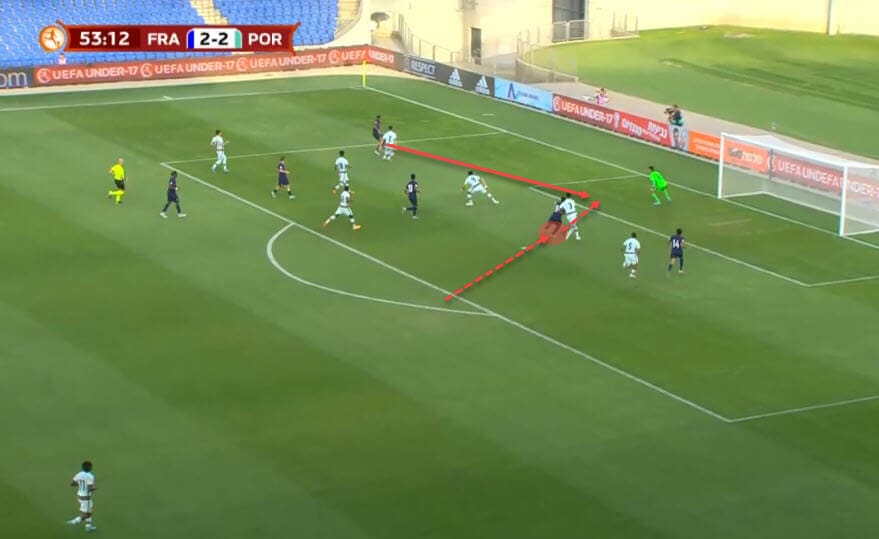
It’s a very similar example but one that demonstrates his most prominent traits quite well once more. Another thing worth pointing out here is again how Tel recognises where the threat is either coming from or going towards and reacts accordingly. This run seems simple but a forward with lesser killer instincts wouldn’t necessarily recognise it in time or at all. Finally, we have to talk about Tel’s shooting technique.
This is just the icing on the cake that is the youngster’s impressive player profile. Let’s get some stats out of the way first though. Given the lacklustre sample, we can only analyse as many as his last 39 shots in the calendar year but it should be sufficient nonetheless. From those 39 shots, 19 have been on target and Tel has scored a total of six goals. Furthermore, 20 shots were taken with the inside of his foot, scoring six goals, and 15 with the top of the foot, emphasising power over placement.
But let’s talk more about his technique beyond the numbers. The following final example shows Tel’s body positioning and leg positioning while taking a shot.
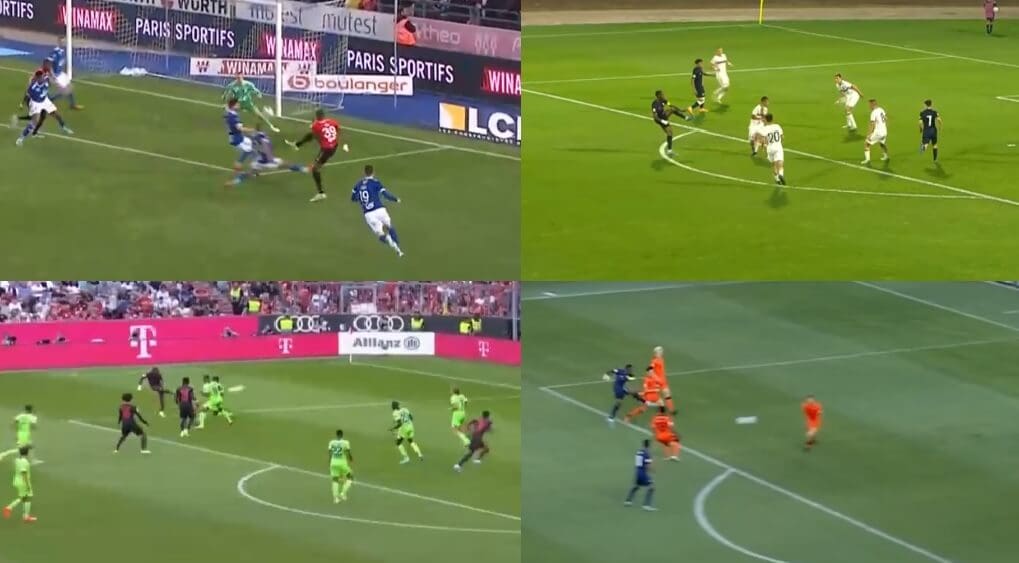
There are a couple of things we’d like to point out here. Firstly, his chest, shoulders and leg positioning. Generally speaking, you don’t want to lean backwards when shooting as that will increase the chance of sending the ball into the stands. Instead, ‘pointing downwards’ and keeping the ball below your chest and shoulders is a general rule to keep the strike grounded. Note, however, that grounded doesn’t have to specifically mean staying fully on the ground but rather, not gaining too much height in its trajectory.
Tel generally does well in this aspect so most of his shots are well-placed with his body in an optimal position. We also have to address the sheer power behind them. One of the reasons Tel attempts so many outside-of-the-box shots is the power he can generate. There are a couple of things to note in power-shots. Firstly, backlift. To explain it in simple terms, backlift represents how much you flick your foot backwards when shooting. Again, speaking in a more general sense, the more backlift you have the more power you generate. However, the very best shooters can generate power with little backlift, meaning there’s a shorter window between getting ready to shoot and actually shooting.
Finally, to generate power players have to follow through the ball or rather, translate their momentum through the ball. This can be seen in our example as well as Tel almost always follows through the ball with his shooting leg. Notice that he even sometimes jumps in the air altogether, using the full range of motion to sustain the momentum. When it comes to the backlift, it’s difficult to say how consistent he can be in retaining power without flicking his legs too much.
For the time being, he’s not at the level of a Harry Kane or Kylian Mbappé, both of whom are experts at this, but then again, he’s only 17. His advantage, however, is that he’s very good at shooting with both feet, albeit, again, the left has somewhat less control. But it’s interesting to note he takes many shots with his instep, giving them a curvature but still striking right through it, retaining power.
All of these things he does so well – from the basics to more advanced aspects – are great indicators of a future elite.
Final remarks
How do you properly explain a 17-year-old is already showcasing the potential to become a future Ballon d’Or winner? It’s an incredibly difficult task at the end of the day. However, Tel exhibits such an overwhelming combination of special traits, pairing up physicality with technicality while already showcasing a high footballing IQ as well, that this statement doesn’t seem (too) out of place.
He does all the basics right and is an incredibly complete player at the tender age of just 17. It doesn’t surprise that many have already compared him to the likes of Thierry Henry, Mbappe or even Nicolas Anelka. Tel is currently a winger but his future lies in the striker position where he can reach the very elite level. He’s explosive, versatile, complete and can perform a variety of different roles from being an outlet and a poacher to a target man or a structure disruptor. His profile is almost unheard of.
Replacing Lewandowski will be an incredibly difficult task but one that he will be well equipped to tackle some years down the line. When you add his capacity for the spectacular into the equation, maybe even sooner.
Simply put, the sky is the limit for Mathys Tel.

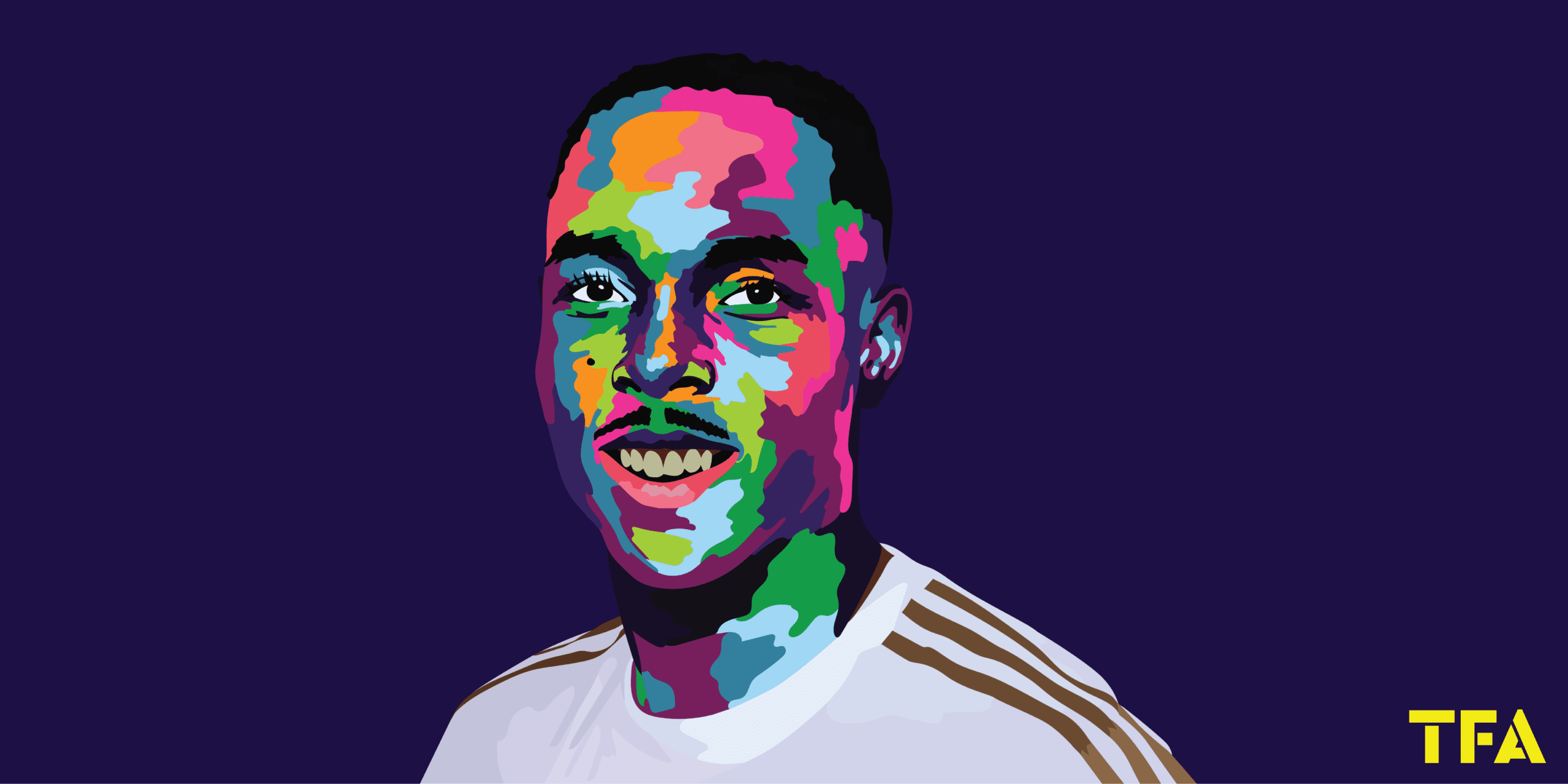




Comments